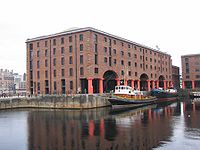
International Slavery Museum
Encyclopedia

Liverpool
Liverpool is a city and metropolitan borough of Merseyside, England, along the eastern side of the Mersey Estuary. It was founded as a borough in 1207 and was granted city status in 1880...
is part of the National Museums Liverpool
National Museums Liverpool
National Museums Liverpool, previously known as National Museums and Galleries on Merseyside, comprises several museums and art galleries in and around Liverpool, England. All museums and galleries in this group have free admission...
group. It is concerned specifically with the Atlantic Slave Trade
Atlantic slave trade
The Atlantic slave trade, also known as the trans-atlantic slave trade, refers to the trade in slaves that took place across the Atlantic ocean from the sixteenth through to the nineteenth centuries...
, rather than the history of slavery
History of slavery
The history of slavery covers slave systems in historical perspective in which one human being is legally the property of another, can be bought or sold, is not allowed to escape and must work for the owner without any choice involved...
in other regions and eras.
The museum is located on the third floor of the building that houses the Merseyside Maritime Museum
Merseyside Maritime Museum
The Merseyside Maritime Museum is a museum based in the city of Liverpool, Merseyside, England. It is part of National Museums Liverpool and an Anchor Point of ERIH, The European Route of Industrial Heritage...
, with the UK Border Agency
UK Border Agency
The UK Border Agency is the border control body of the United Kingdom government and part of the Home Office. It was formed on 1 April 2008 by a merger of the Border and Immigration Agency , UKvisas and the Detection functions of HM Revenue and Customs...
National Museum, 'Seized! The Border and Customs uncovered', located in a gallery in the basement.
Phase 1
The first phase of the new development opened on 23 August 2007. That date marks the 200th anniversary of the 1807 Slave Trade Act, which abolished the slave trade (though not slaverySlavery
Slavery is a system under which people are treated as property to be bought and sold, and are forced to work. Slaves can be held against their will from the time of their capture, purchase or birth, and deprived of the right to leave, to refuse to work, or to demand compensation...
itself) in the United Kingdom
United Kingdom
The United Kingdom of Great Britain and Northern IrelandIn the United Kingdom and Dependencies, other languages have been officially recognised as legitimate autochthonous languages under the European Charter for Regional or Minority Languages...
and its possessions, the tenth International Day for the Remembrance of the Slave Trade and its Abolition
International Day for the Remembrance of the Slave Trade and its Abolition
International Day for the Remembrance of the Slave Trade and its Abolition, August 23 of each year, the day designated by UNESCO to memorialize the transatlantic slave trade. That date was chosen by the UNESCO Executive Board's adoption of resolution 29 C/40 at its 29th session. Circular CL/3494 of...
, as well as, the beginning of the slave uprising in Santo Domingo
Santo Domingo
Santo Domingo, known officially as Santo Domingo de Guzmán, is the capital and largest city in the Dominican Republic. Its metropolitan population was 2,084,852 in 2003, and estimated at 3,294,385 in 2010. The city is located on the Caribbean Sea, at the mouth of the Ozama River...
.
The Merseyside Maritime Museum
Merseyside Maritime Museum
The Merseyside Maritime Museum is a museum based in the city of Liverpool, Merseyside, England. It is part of National Museums Liverpool and an Anchor Point of ERIH, The European Route of Industrial Heritage...
used to house a Transatlantic Slavery Gallery. Phase 1 of the International Slavery Museum involved relocating current exhibitions to the third floor of the museum and adding new displays, which doubled the space dedicated to the subject.
New displays incorporate the latest historical research but also cover wider issues of the legacy of transatlantic slavery, and its contemporary relevance. Topics such as freedom and identity, social justice and human rights, under-development in Africa & the Caribbean, racial discrimination and injustice and the transformation of British and other cultures are covered.
The East Gallery features approximately 400 annotated songs pertaining to the experience of slavery and the music of Africa and the slave-descended African diaspora.
National Museums Liverpool say the new gallery focuses on the experience of individuals, using the narratives of enslaved and those involved in the trade. They include a shrine to the ancestors of the enslaved as a quiet area for contemplation and reflection.
Phase 2
The second phase planned is the development of a new visitor-focused resource centre with an events programme of performance, public lectures and debate. The centre will have a research facility for visiting scholars to work and access to National Museums Liverpool's archive collections. A digital archive of material related to the transatlantic slave trade will be available.To enable phase two of the project National Museums Liverpool has acquired the former Dock Traffic Office, which adjoins the Maritime Museum. The two buildings are to be linked. The Dock Traffic building was formerly occupied by ITV's Granada Television
Granada Television
Granada Television is the ITV contractor for North West England. Based in Manchester since its inception, it is the only surviving original ITA franchisee from 1954 and is ITV's most successful....
.

